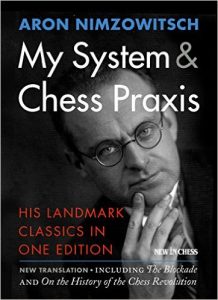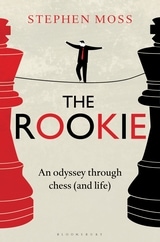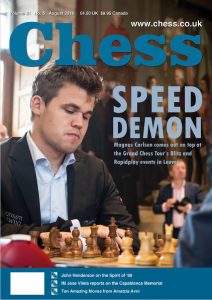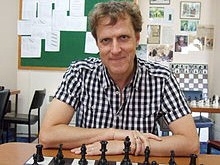 The eNewsletter changes its format once again to counter over-zealous security software, which we find is still stopping some of the emails getting through! We’ll see how it goes this time!
The eNewsletter changes its format once again to counter over-zealous security software, which we find is still stopping some of the emails getting through! We’ll see how it goes this time!
The big news is, of course, the British Championships and Michael Adams’ very convincing performance to become the 103rd British Champion. You will also find IM Gary Lane’s book review, a review of “The Rookie” by Stephen Moss, and much more. Let us know what you think.
If you have any chess news you think we should know about or if you have any comments you would like to make on this newsletter, do contact us at manager.publicity@englishchess.org.uk – the deadline for the newsletter will normally be on the 18th of each month so don’t send us the info too late!
— Mark Jordan, Publicity Manager
103rd British Championships Overview
 The 103rd British Championships which took place at The Pavilion, Bournemouth, was, to slightly adapt a cliché beloved of football pundits, a tournament of two halves: the first 5 rounds gave no indication of what the final result would be. The tournament was distinguished this year by the welcome participation of England’s number 1 player, Michael Adams, which offered a rare opportunity to assess his ascendancy or otherwise against the claims of his ambitious younger rivals who were represented here by David Howell and Gawain Jones. Prior to the tournament Adams had not had, by his standards, a particularly successful year and seen his Elo drop and his world ranking slip out of the top 20; so perhaps he was vulnerable. Howell had reached a rating high in August 2015 with an Elo of 2712 taking him over the 2700 threshold for the first time, but has been unable to keep up the momentum since and slipped back down to 2663; so he had something to prove. Gawain Jones reached a career high of 2671 in January 2015, has maintained a 2600+ rating since 2011 and is habitually highly placed in strong Swiss tourneys, but has yet to establish himself above the 2650 for which he surely has potential. Would he take the opportunity to out-shine Adams, the veteran campaigner?
The 103rd British Championships which took place at The Pavilion, Bournemouth, was, to slightly adapt a cliché beloved of football pundits, a tournament of two halves: the first 5 rounds gave no indication of what the final result would be. The tournament was distinguished this year by the welcome participation of England’s number 1 player, Michael Adams, which offered a rare opportunity to assess his ascendancy or otherwise against the claims of his ambitious younger rivals who were represented here by David Howell and Gawain Jones. Prior to the tournament Adams had not had, by his standards, a particularly successful year and seen his Elo drop and his world ranking slip out of the top 20; so perhaps he was vulnerable. Howell had reached a rating high in August 2015 with an Elo of 2712 taking him over the 2700 threshold for the first time, but has been unable to keep up the momentum since and slipped back down to 2663; so he had something to prove. Gawain Jones reached a career high of 2671 in January 2015, has maintained a 2600+ rating since 2011 and is habitually highly placed in strong Swiss tourneys, but has yet to establish himself above the 2650 for which he surely has potential. Would he take the opportunity to out-shine Adams, the veteran campaigner?
In addition to the top three seeds were several other GMs, all of whom could claim to have a reasonable shot of upsetting the form book and young Australian IM, Justin Tan, who has been resident in England for more than a year thus qualifying for entry to the Championships, and has been enjoying progressively more impressive results and looks to be a strong candidate for the GM title. Jovanka Houska was clear favourite to regain the British Women’s title but had potentially significant competition from Akshaya Kalaiyalahan who won the British Women’s title in 2013 and 2015, in Houska’s absence, had won the 2016 Women’s Grand Prix and, at the age of 14, had qualified for the FM title.
There were no major surprises in the first two rounds but then a flurry of draws in round 3, including Wells v Adams and Eggleston v Jones, saw David Howell on 100% in equal first in the company of, slightly unexpectedly, IMs Justin Tan and Richard Pert. With a Tan v Howell pairing on board 1 it might have been expected that the latter would aim to strengthen his hold on 1st but, in the event, a short draw ensued and this allowed Adams and Jones to join Howell as part of a six-way tie for the lead after round 4. Round 5 saw the Nick Pert v Michael Adams pairing quickly develop into a position where Adams had a miniscule advantage due to his bishop against knight and a better pawn structure and one of his trademark slow grinds looked to be in prospect, but he offered Pert a draw. It seems that Pert was still in his preparation, a fact Adams no doubt suspected, and the favourite therefore erred on the side of caution. Tan v Jones also ended in a draw quite quickly which left the Howell v Arkell battle as the only really interesting encounter of the round among the leaders. And interesting it was with Arkell allowing Howell to develop an early initiative and then counter-attacking on the Queens-side to create the kind of unbalanced position in which he often excels. After considerable complications, however, in which Arkell missed some hard to find continuations, Howell eventually came out victorious and, due to the draws among the other leaders, now found himself in sole 1st position going in to round 6. It would be fair to say that at this stage of the tournament Adams had not stamped his authority on the field and, although he was most certainly in the mix, the possibility that one of his rivals would win was very real. Having said that, Adams had yet to play the 2nd and 3rd seeds so all was still in the melting pot. If anyone had developed any doubts about Adams’ continuing to be a class act on the basis of his workmanlike but unspectacular progress through the first 5 rounds, his performance from round 6 through to the end of the tournament resoundingly disproved any such notion! But I get ahead of myself.
Round 6 saw the first encounter among the top seeds with Jones v Howell. If Howell had won this encounter he would both dispense with a major rival and be in an excellent position to take the title but a hard fought game ended in a draw which allowed Adams to catch up having outplayed Justin Tan. Joining them on = 1st was IM David Eggleston who had drawn with Gawain Jones in round 3, defeated a somewhat off-form Mark Hebden in round 4 and had beaten John Emms this round. Eggleston seems to have moved in to a new class of late, has scored some significant results elsewhere over the last few months and was here destined to achieve a 9-round GM norm for his performance over the first 9 rounds.
Round 7 saw the crunch match between Howell and Adams which saw the latter victorious and taking over the lead whilst consigning the former to the chasing pack. Eggleston who had been cutting something of a swathe through GM opposition, beat Keith Arkell with White and Joined Adams at the top. By this time Eggleston had already dome enough to secure his 9-round GM norm.
Round 8 had the leaders paired and Adams defeated Eggleston to take sole lead for the first time. Gawain Jones beat Nick Pert to secure sole second and line himself up with the White pieces to face Michael Adams who was now building a serious head of steam.
Round 9 saw Adams defeat Jones, thus dispensing with both his main rivals and securing a clear point over David Howell who had leap-frogged over Jones having defeated Eggleston.
Adams won again on round 10, this time against a wry looking Gormally, and now looked unstoppable. Howell beat Nick Pert with White and was a point clear in 2nd place. Thus we were left a situation whereby if Adams was to lose in the final round, Howell could catch whilst a draw would be sufficient for Adams to take the championships. Adam’s opponent, Martin Brown, would have been very agreeable to a draw as this would have given him an IM norm after a fine tournament performance but Adams, who had a grading advantage of nearly 500 points over his opponent, had other ideas. He crushed his opponent in short order and thus won the Championships with 10/11, thus equalling the record set by Julian Hodgson in 1992. Howell, on seeing the result of Brown v Adams, could have sought a draw with Emms to guarantee second but the Board 2 game was in fact the last to finish and Howell came out the victor.
On Board 4, Justin Tan, who need a win to secure a GM norm based on his performance from Rounds 3-11, faced David Eggleston who already had a Norm for his 1-9 performance. Tan had been playing consistently strongly through-out and took the game to secure a very well-deserved norm.
Jovanka Houska played well to win the Women’s title but, in truth, had little opposition this year as Kalaiyalahan, after an excellent year, was unaccountably off-form and presented no challenge.
For Adams to win his last 6 games of the British was a great achievement and, given he was up against 2 of his most serious rivals, he proved that he is still in a class on his own in English chess. As a result of his performance he also jumped up the Fide Ranking and finds himself back in the World top 20. He is due to play in the Isle of man and it has just been announced that he will be the wild card at the London Classic so let’s hope his performance here is indicative of things to come.
Carl Portman, ECF Manager of Chess in Prisons, continues his tour of prisons in the UK in an initiative the value of which has been acknowledged by the prisons, the prisoners and even the minister, and which has even generated interest in the States …
Visit to HMP Wormwood Scrubs on 16 August 2016
HMP Wormwood Scrubs is a Victorian-built ‘local’ prison, Category B which holds up to 1279 adult males in the early stages of custody remanded from local Magistrates and Crown Courts. During World War II the prison was taken over by the War Department and the prisoners evacuated. It was used as secure office space for the duration of hostilities and housed MI5 and MI8. The two oval plaster reliefs on the front of the prison (Grade II listed) depict Elizabeth Fry and John Howard both well-known figures of Prison reform.
My visit programme differed to any I have conducted before. Whereas usually I take on all-comers in a simultaneous display I worked with a class of beginners in the prison education centre to introduce them to chess. The prison had selected 8 inmates (for security reasons there could be no more in the class) and apart from two they basically had to start from scratch.
After explaining the history of chess, the rules and having an open Q&A session, the class were ready to try a game and it went very well. Indeed one of the prisoners saw a checkmate that I myself had overlooked! I was so busy trying to explain another issue that I did not look for the mate. That earned a book prize and he was one very happy prisoner amongst his peers. This had a tremendous effect. I explained that despite playing for decades I always keep learning myself and chess players don’t have all the answers. They were pleased that I ‘owned up’ to not seeing the mate instead of saying that I saw it and was testing them. I think my honesty set the tone for the session.
The mix of British and Foreign Nationals worked very well together, helping each other (with a fair amount of prison banter thrown in!) to understand the game. We quickly established a rapport and it was once again clear to me and others that chess had the effect of bringing people together, smashing down barriers and utilising time in a positive way. Moroccan, African, British and other prisoners created an International feel to proceedings. Despite there being a walkout by staff in May – reported in the National press – because they no longer felt safe at the prison, I had no concerns at all and was indeed alone with inmates for a while. Chess won the day and it truly is an International language that we are all able to speak.
The Governor and all staff that I spoke to were very pleased (At least one seemed to be quite surprised indeed) about how the day went and I was told that the intention is to keep chess going at HMP Wormwood Scrubs. To my knowledge this has never happened before in terms of forming an official club so it is ground breaking work.
I very much want chess to continue here and I have offered myself as an advisory resource for them in their quest to build on the foundations of my visit. I offer one light-hearted note. I was amused at the language the inmates used when the king was being hunted down to checkmate. They would say “Shut the position down” which actually seems to be very relevant. I guess there is a shut-down of an evening in a prison and this works on a chessboard too.
My grateful thanks to Maria Salgado for facilitating my visit and to the Governor for giving his blessing. Thanks also to the inmates who attended. They were courteous and keen and everyone participated. I hope they continue to learn and grow as a chess team and as individuals. Many thanks also to the English Chess Federation for supporting chess in prisons. It really is making a difference.
— ECF Manager of Chess in Prisons, 17 August 2016
Visit to HMP Huntercombe on 11 August 2016
HMP Huntercombe is situated in South Oxfordshire. It is a Category C prison holding mostly foreign nationals. It opened as a prison in 1946, the site was originally built as an internment camp during the last war, when for a short period it held Rudolf Hess, on his way south after he famously parachuted into Scotland.
I was invited by Rev Ian Thacker, chaplain at the prison who also manages the hugely impressive prison chess club.
After arriving at around 12:45 Ian met me and we walked around the prison, chatting to various inmates about the chess events to come. I could immediately see the rapport between Ian and the prisoners. When the day started I received a nice introduction, welcoming me and the English Chess Federation into the prison.
I began with a chess question and answer session but this was combined with showing openings, endings, tips and hints on a chess board. I also played a game against all inmates on one board, talking through various tactical and strategical issues. The questions were excellent and demonstrated early on that the inmates played chess to a very competent level – perhaps a worrying portent for my simultaneous display to come.
After this I gave a simultaneous display of somewhere around 12 boards and as expected I had many hard fights losing a couple of games and I think drawing two. This was all taken in a great spirit and there were no issues at all on any boards. This is a credit to the inmates.
After several hours, inmates had to return to cells, only to come back later for more chess! In the evening I was a special guest and the winner of the prison chess championships had the ‘honour’ (prison term, not mine!) of playing me one to one in the evening session. Frankly I was astonished at the vibe in the club. It was filled with people but you could hear a pin drop throughout. There was a wonderful discipline, allowing everyone to contemplate their moves in a quiet atmosphere that I have rarely encountered in any chess club.
Ian’s view on this is that it creates a sanctuary for inmates where they can come to a quiet place, play chess and drink some coffee or tea. It must be an absolute blessing for inmates, and it was heartening to see the fruits of their work as people enjoyed the games together. Ian really had a special rapport with the chess players that I have rarely seen between prisoners and staff.
It was clear once again that chess has no barriers. During my simul there were players of many nationalities, white and black, various religions, and differing abilities/disabilities. It was good also to see young and older players participating. Chess brings people together and this is perhaps especially important in a prison, where tensions can run high for many reasons. It may have been a prison but there are no bars to chess.
I should note also that each week, volunteer chess players attend the club to play against inmates. I was delighted to see a couple of faces I knew from a local league. This is proof that much good work is going on behind the scenes that does not get the publicity it deserves. I donated several books, a chess set and boards and some magazines which were eagerly received and the chess club now has some useful books to share around to help inmates improve their game.
I wish to extend my thanks to Ian for inviting me and pro-actively supporting chess activities at HMP Huntercombe. Thanks also to the prison staff, and the inmates who participated for making the day so special. In many ways, they are the stars. My grateful thanks to the English Chess Federation for its continued support for me doing this crucial work
— ECF Manager of Chess in Prisons, 12 August 2016
Book Review by IM Gary Lane
My System & Chess Praxis by Aron Nimzowitsch
Published by New In Chess, 576 pages, £21.99
 How to be good at chess? This has always been the problem once you have mastered the basics and when I was young the answer was to read My System. The hope was it would explain how to think at the board and it should certainly help the studious student. However, in the recent book, Chess for Life, Nigel Short revealed what a lot of masters really think, “I do think though that My System is a dreadfully boring book.” You might be surprised to learn that the publisher decided not to use this quote! Then again, Nigel is probably thinking back to what was available when we were kids and the New In Chess publication is a vast improvement. There used to be tiny writing to cram as many words on the page as possible to save money, while diagrams were scarce and the translation into English seemed far too advanced.
How to be good at chess? This has always been the problem once you have mastered the basics and when I was young the answer was to read My System. The hope was it would explain how to think at the board and it should certainly help the studious student. However, in the recent book, Chess for Life, Nigel Short revealed what a lot of masters really think, “I do think though that My System is a dreadfully boring book.” You might be surprised to learn that the publisher decided not to use this quote! Then again, Nigel is probably thinking back to what was available when we were kids and the New In Chess publication is a vast improvement. There used to be tiny writing to cram as many words on the page as possible to save money, while diagrams were scarce and the translation into English seemed far too advanced.
This brand new edition represents excellent value for money as Nimzowitsch’s other classic work, Chess Praxis, is included along with a couple of essays. The cynic might point out that such a feat is possible because there is no longer copyright to pay but for the chess reader it is excellent news. The translator, Robert Sherwood, has been warmly congratulated by some eminent players so that must be a good sign that it is more readable.
If you have the time and patience Nimzowitsch will help you to advance to the next stage. This edition naturally looks like a modern book with lots of diagrams and plenty of space so that reading it is easy. This all makes it highly recommended.
If you have never read the insights that Nimzowitsch has to offer, this timeless classic should be ordered now.
THE ROOKIE: An odyssey through chess (and life)
Stephen Moss; Bloomsbury Press: Published 22/9/16
 Stephen Moss is a journalist who is best known and most prolific as a feature writer for the Guardian. He has written on a broad spectrum of subjects in no-nonsense journalistic vein, but perhaps his most memorable work is in his “everyman” persona where he gutsily, self-deprecatingly and humorously takes on tasks and disciplines for which he does not claim special expertise but, in a way, lives the experience for the benefit of the reader. ‘The Rookie‘ finds him very much in the ‘Everyman’ mode and, although he has played chess over many years, he is at pains to announce his dilettante relationship with the game and his own frailties as a player are a central point of the book. Revolving around his attempt to take his chess development seriously at the rather advanced age of 55, he employs the help of former Welsh International and BCM editor, John Saunders, to give him expert playing advice as he undertakes a three-year odyssey of club and congress chess in the UK, as well as trips to Europe, Russia and the United States. His own over-the-board and travelling experiences are punctuated by his take on chess history and development, and his discussions with various prominent chess figures on playing chess and its future as a sport or pastime. At the end of the book he rather bravely includes a number of his games referred to in the text (annotated by Saunders with comments from Moss).
Stephen Moss is a journalist who is best known and most prolific as a feature writer for the Guardian. He has written on a broad spectrum of subjects in no-nonsense journalistic vein, but perhaps his most memorable work is in his “everyman” persona where he gutsily, self-deprecatingly and humorously takes on tasks and disciplines for which he does not claim special expertise but, in a way, lives the experience for the benefit of the reader. ‘The Rookie‘ finds him very much in the ‘Everyman’ mode and, although he has played chess over many years, he is at pains to announce his dilettante relationship with the game and his own frailties as a player are a central point of the book. Revolving around his attempt to take his chess development seriously at the rather advanced age of 55, he employs the help of former Welsh International and BCM editor, John Saunders, to give him expert playing advice as he undertakes a three-year odyssey of club and congress chess in the UK, as well as trips to Europe, Russia and the United States. His own over-the-board and travelling experiences are punctuated by his take on chess history and development, and his discussions with various prominent chess figures on playing chess and its future as a sport or pastime. At the end of the book he rather bravely includes a number of his games referred to in the text (annotated by Saunders with comments from Moss).
Moss’ mission does seem rather Quixotic, and his admitted inability to really knuckle down and study quickly leads to the expectation, eventually confirmed, that his rise through the chess rankings is not meteoric. Many of his experiences would, I think, be common to most chess players at lower levels in competitive chess and, to that extent, there is little new to learn from this book, although Moss can tell a good story and his humour is endearing. His characterisations of common-or-garden chess players as “retired accountants” or the socially inept does hold some elements of truth, but it makes the chess scene sound rather sadder than it actually is. In my experience, whilst the characters Moss describes do exist on the tournament chess circuit, there is far more variety than he appears to notice and, whilst accurate in many ways, his tendency to hit those easy targets does lead to a very partial account of chess players and their world, which is likely to irk some people and puzzle and possibly alarm the general reader.
Having said all this, I enjoyed the book and I think it provides an entertaining tour of chess and its place in the modern world. Whilst not an essential addition to a chess player’s library, I would recommend it as light reading, and certainly a good way to wind down from studying minor-piece endings.
You can get a copy of the book a discount if you go to the Bloomsbury website and quote the code Rookie25
— Mark Jordan
CHESS Magazine – excerpt [click here]
 Chess magazine have given us permission to re-publish an excerpt from their August edition. This time we’ve chosen, a little unusually, the editorial (!), which is more interesting than it sounds, as it includes some interesting analysis of some important games, plus some challenging perspectives from the editor, Malcolm Pein. If you wish to subscribe to the magazine then you can go to the website –
Chess magazine have given us permission to re-publish an excerpt from their August edition. This time we’ve chosen, a little unusually, the editorial (!), which is more interesting than it sounds, as it includes some interesting analysis of some important games, plus some challenging perspectives from the editor, Malcolm Pein. If you wish to subscribe to the magazine then you can go to the website –


